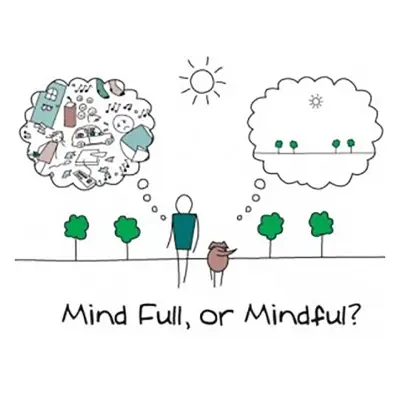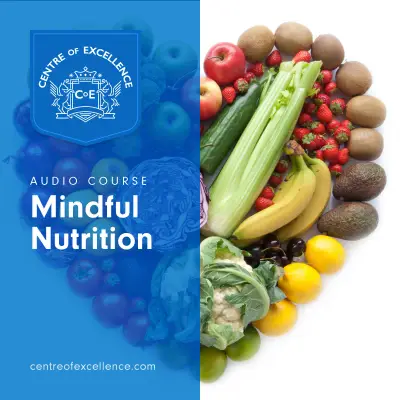In today’s world, many people are searching for ways to find peace and balance in their lives. One of the most effective ways to achieve this is through mindfulness. But what is mindfulness, and how can you practice it? This blog post guides you through the basics of mindfulness, explain its benefits, and provide practical tips on how to incorporate it into your daily routine.
Jump to:
What is Mindfulness?

Mindfulness is a mental state achieved by focusing your awareness on the present moment while calmly acknowledging and accepting your feelings, thoughts, and bodily sensations. It's about being fully engaged in whatever you are doing at the moment without being overly reactive or overwhelmed by what’s going on around you.
Recommended for you!
Best SellersThe Definition of Mindfulness
The definition of mindfulness, according to Jon Kabat-Zinn, the founder of Mindfulness-Based Stress Reduction (MBSR), is "paying attention in a particular way: on purpose, in the present moment, and non-judgmentally." This practice can help you develop a deeper awareness of your thoughts and feelings, leading to greater emotional stability and overall well-being.
Why Practice Mindfulness?
Practicing mindfulness offers numerous benefits, including reduced stress, improved focus, and enhanced emotional regulation. It helps you respond to situations more thoughtfully rather than reacting impulsively. Here are some reasons why you might want to incorporate mindfulness into your life:
- Stress Reduction: Mindfulness helps to lower cortisol levels, the hormone associated with stress.
- Improved Concentration: By training your mind to stay focused on the present moment, you can enhance your concentration and productivity.
- Emotional Regulation: Mindfulness allows you to better understand and manage your emotions.
- Better Relationships: Being present in your interactions can improve your relationships with others.
- Enhanced Self-Awareness: Mindfulness helps you become more aware of your thoughts, feelings, and behaviours, leading to greater self-understanding.
- Reduced Anxiety: Regular mindfulness practice can help reduce symptoms of anxiety and promote a sense of calm.
- Improved Physical Health: Mindfulness has been linked to lower blood pressure, improved sleep, and better overall physical health.
- Increased Resilience: Mindfulness can help you develop resilience, making it easier to cope with life's challenges and setbacks.
- Greater Creativity: Being mindful can enhance your creativity by allowing you to approach problems and tasks with a fresh perspective.
- Pain Management: Mindfulness techniques can help manage chronic pain by altering your perception of pain and reducing its intensity.
- Better Decision-Making: By fostering a clear and calm mind, mindfulness can improve your ability to make thoughtful and informed decisions.
- Enhanced Emotional Intelligence: Mindfulness can increase your ability to recognise, understand, and manage your own emotions and those of others.
- Boosted Immune System: Some studies suggest that mindfulness can enhance your immune system, helping you to stay healthier.
- Increased Patience and Compassion: Mindfulness practice can help cultivate patience and compassion towards yourself and others.
- Improved Memory: Regular mindfulness practice has been shown to enhance working memory and cognitive function.
- More Joy and Satisfaction: By focusing on the present moment, mindfulness can increase your overall sense of joy and life satisfaction.
How to Start Practicing Mindfulness

Starting a mindfulness practice doesn’t have to be complicated. Here are some simple steps to get you started:
1. Start with Short Sessions
If you're new to mindfulness, it's best to start with short sessions of 5-10 minutes. Gradually increase the time as you become more comfortable with the practice. Short sessions can be easily integrated into your daily routine, making it more likely that you'll stick with it. Set aside a specific time each day, perhaps in the morning or before bed, to dedicate to mindfulness.
2. Focus on Your Breath
A simple way to begin is by focusing on your breath. Sit comfortably, close your eyes, and take deep breaths. Pay attention to the sensation of the air entering and leaving your body. Notice the rise and fall of your chest, the feeling of the air passing through your nostrils, and the sound of your breath. If your mind wanders, gently bring your focus back to your breath. This practice helps anchor you in the present moment and can be done anywhere, anytime.
3. Adopt Mindful Eating Practices
Instead of rushing through meals, take time to savour each bite. Notice the taste, texture, and aroma of your food. Pay attention to the colours and shapes on your plate. Chew slowly and thoroughly, appreciating the effort that went into preparing the meal. Eating mindfully can enhance your enjoyment of food and help with digestion. It can also prevent overeating by allowing you to recognise when you’re full.
4. Practice Mindful Listening
When engaging in conversations, give the other person your full attention. Listen without planning your response while they are speaking. Focus on their words, tone, and body language. This can improve your communication skills and strengthen your relationships. Mindful listening shows respect and empathy, creating a deeper connection with others. It also allows you to respond more thoughtfully rather than reacting impulsively.
5. Create a Mindful Environment
Set up a quiet, comfortable space in your home where you can practise mindfulness. This could be a corner of a room with a cushion or chair, some calming decorations, and perhaps some soothing background music or sounds. Having a dedicated space can make it easier to focus and create a habit.
6. Use Mindfulness Reminders
Incorporate mindfulness into your daily routine by setting reminders. Use your phone, sticky notes, or other cues to remind yourself to pause and be mindful. For example, you might set a reminder to take a few deep breaths every hour or place a note on your computer to practise mindful posture.
7. Engage in Mindful Activities
Bring mindfulness into everyday activities like walking, cleaning, or exercising. For example, while walking, pay attention to the sensation of your feet touching the ground, the rhythm of your steps, and the sounds around you. During exercise, focus on your body's movements and how your muscles feel.
8. Journal
Keep a mindfulness journal to reflect on your practice. Write about your experiences, any challenges you face, and the benefits you notice. Journaling can help you track your progress, stay motivated, and deepen your understanding of mindfulness.
9. Seek Support and Guidance
If you find it challenging to maintain a mindfulness practice on your own, consider joining a mindfulness group or taking a class. Connecting with others who are also practising mindfulness can provide support, encouragement, and new insights.
Strategies for Mindfulness in Daily Life
Incorporating mindfulness into your daily routine can be simple and straightforward. Here are some practical strategies to help you stay mindful throughout the day:
Morning Routine
Start your day with a few minutes of mindfulness meditation. This can set a positive tone for the rest of your day. Focus on your breath or engage in a body scan to bring awareness to your body and mind.
Mindfulness at Work
Take short breaks throughout your day to practise mindfulness. Stand up, stretch, and take a few deep breaths. You can also practise mindful walking by paying attention to the sensations in your feet as you walk.
Evening Routine
Before going to bed, take a few moments to reflect on your day. Think about what you are grateful for and any positive experiences you had. This can help you unwind and improve the quality of your sleep.
How Many Minutes a Day Should You Be Mindful?
Even a few minutes a day can make a difference. Aim to practise mindfulness for at least 10-15 minutes daily. As you become more comfortable with the practice, you can gradually increase the duration.
Fun Mindfulness Activities

Mindfulness doesn't have to be boring. Here are some fun activities you can try to make mindfulness a part of your life:
1. Colouring
Adult colouring books can be a relaxing and mindful activity. Focus on the colours and patterns, letting go of any other thoughts. As you colour, immerse yourself in the process, noticing the way the colours blend and how the patterns take shape. This simple activity can help you calm your mind and bring your attention to the present moment.
2. Nature Walks
Spend time in nature, paying attention to the sights, sounds, and smells around you. This can be a refreshing way to practise mindfulness and connect with the natural world. Notice the rustling of leaves, the chirping of birds, and the fragrance of flowers. Walking mindfully in nature can also improve your mood and reduce stress, making it a great way to recharge.
3. Cooking
Engage in mindful cooking by paying attention to the textures, smells, and tastes of the ingredients. This can make the process more enjoyable and help you create delicious meals. As you chop, stir, and season, focus on each action. Notice the colours of the vegetables, the sound of sizzling, and the aroma of spices. Mindful cooking transforms a routine task into a sensory experience.
4. Mindful Gardening
Gardening is another excellent way to practise mindfulness. Pay attention to the feel of the soil, the smell of the plants, and the sight of flowers blooming. Notice the textures of leaves, the sound of rustling branches, and the warmth of the sun. Gardening mindfully can be both relaxing and rewarding as you connect with nature and watch your efforts flourish.
5. Mindful Drawing or Painting
You don't need to be an artist to enjoy mindful drawing or painting. Focus on the movement of your hand, the flow of the paint or pencil on paper, and the emerging image. Let go of any judgments about your skills and simply enjoy the creative process. This activity can help you express yourself and find peace in the moment.
6. Puzzles and Games
Engage in puzzles and games that require focus and attention. Activities like jigsaw puzzles, Sudoku, or board games can be mindful when you immerse yourself fully in the task. Concentrate on each piece or move, noticing how it fits into the bigger picture. These activities can be both fun and mentally stimulating.
7. Music and Dance
Listening to music or dancing mindfully can be a joyful way to practise mindfulness. Pay attention to the rhythm, melody, and lyrics of the music. If you're dancing, focus on the movement of your body and how it responds to the beat. Let the music guide you and allow yourself to be fully present in the experience.
8. Mindful Photography
Take up photography as a mindful hobby. Explore your surroundings with a camera, focusing on capturing the beauty of everyday moments. Pay attention to lighting, composition, and details that you might usually overlook. This practice can help you see the world with fresh eyes and appreciate the present moment.
9. Mindful Breathing Exercises
Engage in mindful breathing exercises throughout the day. For example, try the 4-7-8 technique: inhale for four seconds, hold your breath for seven seconds, and exhale for eight seconds. This simple practice can be done anywhere and anytime to help you centre yourself and reduce stress.
10. Creative Writing
Try creative writing or journaling as a mindful activity. Write about your thoughts, feelings, or experiences without worrying about grammar or structure. Let the words flow naturally and focus on expressing yourself. This can be a therapeutic way to explore your inner world and stay present.
11. Playing an Instrument
If you play an instrument, practise mindfully by focusing on each note and the sensation of playing. Pay attention to the sound, the movement of your fingers, and the vibration of the instrument. This can deepen your connection with the music and enhance your overall playing experience.
12. Yoga and Tai Chi
Practising yoga or tai chi mindfully involves focusing on your movements, breath, and body sensations. These activities promote relaxation, flexibility, and balance, making them excellent for both physical and mental well-being. Each pose or movement becomes an opportunity to practise mindfulness and stay present.
Recommended for you!
Best SellersFrequently Asked Questions About Mindfulness
What is the first step to mindfulness?
The first step to mindfulness is simply becoming aware of the present moment. This can be achieved by focusing on your breath or by paying attention to your surroundings, thoughts, and sensations without judgment.
How do I start a mindfulness routine?
To start a mindfulness routine, begin with short, daily sessions of 5-10 minutes. Gradually increase the duration as you become more comfortable. Choose a quiet, comfortable place to practice, and set a specific time each day to help establish the habit.
How do I calm my mind from overthinking?
To calm your mind from overthinking, try mindfulness techniques such as deep breathing exercises, body scan meditation, or mindful walking. Focus on your breath or a single point of attention to help quiet your thoughts.
What is the 3-3-3 rule in mindfulness?
The 3-3-3 rule is a grounding technique used to reduce anxiety and bring you back to the present moment. It involves naming three things you see, three sounds you hear, and moving three parts of your body (e.g., fingers, toes, shoulders).
Can you learn mindfulness on your own?
You can learn mindfulness on your own through books, online resources, and mindfulness apps. These tools provide guided meditations, exercises, and tips to help you develop a consistent practice.
What are the 4 Cs of mindfulness?
The 4 Cs of mindfulness are Calmness, Clarity, Compassion, and Curiosity. These qualities help you approach mindfulness practice with a balanced and open mindset.
Why is it so hard to practice mindfulness?
Practising mindfulness can be challenging because it requires breaking habitual patterns of thinking and reacting. It takes time and consistent practice to train your mind to stay present and non-judgmental.
Why can't I do mindfulness?
Difficulty practising mindfulness often stems from high expectations or impatience. It's normal for the mind to wander. The key is to gently bring your focus back to the present moment without self-criticism. Regular practice will make it easier over time.
What are the 4 Ts of mindfulness?
The 4 Ts of mindfulness are Time, Technique, Trust, and Tenacity. Allocating time for practice, using effective techniques, trusting the process, and being tenacious in your practice are essential for developing mindfulness skills.
Can you overdo mindfulness?
While mindfulness is beneficial, it's important to find a balance. Practising mindfulness excessively can lead to an over-focus on the present moment, potentially neglecting other important aspects of life. Moderation is key.
Who should not practice mindfulness?
While mindfulness is generally beneficial, it may not be enough of a treatment for everyone. People with severe mental health issues, such as PTSD, severe anxiety, or depression, should consult a healthcare professional before starting a mindfulness practice.
Study Mindfulness for £29
If you're ready to deepen your mindfulness practice, consider enrolling in the Mindfulness Diploma Course at Centre of Excellence. This fascinating course is designed for people of all levels and experiences and is currently available for a discounted price of £29.













